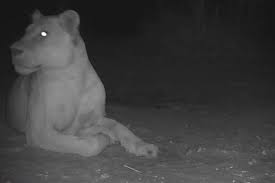A lioness has been spotted in a reserve in Chad, which has not recorded one since 2004!

Lions have not been spotted in the Chad national park of Sena Ouro since 2004, it is not clear if a few lions hung on for the last few decades or if lions have migrated over from a park the other side of the border in Cameroon, where the lion population is a little more healthy.
However, with the west African lion species being this wide spread, and low in numbers, it means that in many reserves it can be many years between sightings. In this instance in the Sena Oura National park in Chad, they haven’t been seen since 2004 or for 19 years. Below is a table which lists the estimated figures for lions in various reserves in west and central africa.
As you can see from this list, no population is large, so in order to stop the western and central lion populations sliding towards 0, humanity needs to get involved by translocating lion prides between reserves to increase genetic variability.
Other sources claim a population of only 250, with 90% of these live in the W-Arly-Pendjari reserve which straddles the borders of Benin, Niger, and Burkina faso with the rest split between Niokolo-Koba National Park in Senegal with 10-15, and two sites in Nigeria- Yankari National park where there are thought to be just 5 animals (at most) and Kainji Lake National Park with around 30 members.
The central African lion numbers are a bit higher as you can see from the table, so perhaps we can stop this group of populations getting so small.
This gives an estimate of 1800 to 3800 members of the Asiatic lion population still in existence in Africa. It also means that the Asiatic lion (or Indian lion) is between 300 and 600% more numerous in Africa than in Asia. By moving animals around, protecting reserves more effectively, and translocating prides to reserves which only recently lost the Lion.
One question arises from these figures – if there are 3 to 6 times as many Asiatic lions in Africa, should this species be renamed?
Certainly, what is clear, is that historically the “Asiatic lion” had more habitat in Africa than in Asia. Indeed, back around the time of Jesus, Lions still lived in places like Spain and Italy – which in evolutionary terms is a blink of an eye
Further analysis has shown that the Barbary lion was also part of this subspecies – which gives further hopes to the idea of reintroducing lions into the barbary lion range. While there are unlikely to be any reserves that are instantly capable of taking lions, with some work this should be able to change. Having said this, translocations must be handled carefully, otherwise we might loose the last few barbary Leopards in the process.
What is exciting about this most recent analysis, is that essentially all the lion populations in the blue areas of the map, can be considered one mega population. By moving animals or prides between reserves we can improve the genetic diversity of the whole population.
Furthermore, by recognizing these lions as one population, it would be possible to move prides from reserves where there isnt space into ones elsewhere. It has also been shown that the Barbary lion came from this population (in other words in not a separate population).
Rabat zoo in Morrocco still holds a group of lions descended from wild Barbary Lions kept in the palace grounds. There is an aim to reintroduce lions to the Atlas mountains of Morrocco, and if it is possible to boost the Barbary population with closely related animals from elsewhere, this could happen faster.
